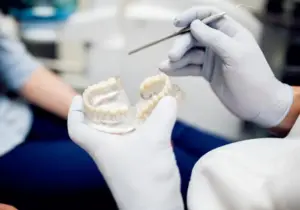Maybe you heard a great joke, ran into an old friend or just received a promotion at work. You felt a good feeling and, automatically, a smile came to your face. It’s easily the most common and most immediately-recognizable facial expression, and we use it to navigate our day, socially – the way we appear, speak, eat, etc.
We already know how saturated our society is with cosmetic dentistry; you can’t go to the grocery or ride the subway without seeing advertisements for procedures and products that promise to whiten your smile, straighten your teeth or freshen your breath. It’s all about appearance, right?
Not really.
Grinning Ear-to-Ear: Smiling as a Social Signal
Where did smiling come from? Great question. The origins of smiling are often opaque, and more complicated than smile = good. We have a decent understanding of certain smile mechanisms, but not a lot going to put these disparate facts and assumptions together:
- The purposeful act of smiling most likely traces back to the primate stages of human evolution. In many primate species, a silent baring of teeth with relaxed lips is meant to say, “Hey – I’m not trying to fight you.”
- All cultures use specific mouth shapes as social signals, and the way our society views smiling isn’t a universal concept. It’s really not even country-wide, as any Ohioan who has let the state can attest.
- If a smile has positive emotion behind it, the eye muscles will also be involved. Think laugh lines. This is called a Duchenne smile.
- Babies use wide-toothed smiles as a way to express discomfort, and softer smiles to express contentment… we think.
- Children who are born blind exhibit the same reactive smiling behavior as kids with sight.
- Duchenne smiles have been observed in neonatesat 33-34 weeks of gestation, and at 30 weeks in babies born pre-term, indicating that true smiles are an innate behavior.
- Some academics explain the deficit of smiles in historic portraiture as a way to hide tooth rot/decay/missing teeth, which were often associated with lower classes.
- Smiling in photos didn’t become the norm until the 1950’s.
Bite-Size Psych: The Perception of Smiles
There’s a whole sub-field of psychology dedicated to smiles: how they affect others and how they affect the self. Until the ‘70s, academics thought smiles meant a bunch of different things. But if you think about it, there are different kinds of smiles: nervous smiles, fake smiles, deceitful smiles, leers.
And some smiles aren’t often accompanied by any emotion. Think about the passing smile you give a stranger passing you on the street or the smiles of politicians in publicity shots. These are likely those you-can-trust-me remnants of our primate history. What psych focuses on is sussing out those Duchenne smiles amongst all the others, because those are the innate, true smiles:
People like authentic smiles more.
In a breakthrough study published in 1990, researchers confirmed that Duchenne smiles correlate with positive stimuli, do not correlate with negative stimuli, and that Duchenne smiles increase activity in the region of our brain associated with positive affect. A slew of subsequent studies demonstrated that Duchenne smiles were always followed by positive emotions, and that people can visually tell the difference between a Duchenne and other types of smiles.
Positive affect protects well-being.
Studies working in the same theoretical framework as that foundational 1990 study also found correlations between Duchenne smiles and long-term well-being. A 30-year longitudinal study using photos from women at age 21 and then interviewing them at age 52 found the women who demonstrated a Duchenne smile in the initial photo ranked higher in general wellbeing and marital satisfaction. A related study then confirmed that non-Duchenne smiles in candid photos correlated with higher divorce rates.
Smiling leads to better social interactions.
When you smile at someone, 4/5 times it’s reciprocated. When they smile, their brain releases those feel-good hormones, which makes them want to interact with you and causes them to associate you with positive feelings. Studies have shown a positive correlation between intense smiling, perceived attractiveness, and trustworthiness.
True smiles help you live longer.
To take it to the absolute life-and-death level, a study published in 2011 analyzed the smiles of pro baseball players using yearbooks from 1952. They weighed the veracity of their smiles in the photos to their lifespan. They connected 35% of lifespan variability to smile intensity, and even showed that in any given year, players with Duchenne smiles in those 1952 yearbooks were half as likely to die as those who displayed low-intensity smiles.
Grin & Bear it: Smiling & Quality of Life
So how do these isolated findings play out together in our real lives? Smiling affects every important aspect of our day-to-day, as well as overall health. It’s well-documented that true smiles can directly alter someone’s behavior; it signals good intentions, which causes the other person to anticipate positive interactions, leading them to approach you with the same.
Smiling is, at its core, about fending off rejection. Think about it: that baboon who’s silently baring its teeth is either trying not to get beat up or cast away. That politician kissing babies is trying to win votes. The new person at the office is smiling and shaking hands to ingratiate themselves with their new cohorts. Failing to give a smile can spur detached or negative interactions, just like failing to receive a smile can cause feelings of rejection.
Researchers have identified several ways a smile’s social actions affect us mentally and physically:
- It helps form connections. The brain mirrors smiling and laughing behavior, indicating reciprocal cooperative intentions and helping to build strong bonds.
- It makes our brain happy. A true smile releases three hormones key to feeling good: serotonin, dopamine and endorphins. Smiling does this more effectively than chocolate and maybe as effectively as exercise.
- It preserves close relationships. In couples, laughter frequency during interactions is directly associated with perceived relationship quality, support and closeness.
- It makes you more productive. A company’s happiest workers spend up to twice the percentage of their work hours on productive tasks than the least-happy workers.
- It helps manage stress. Laughter increases circulation, helping muscles to relax, lowering blood pressure and heart rate, and protect you from physical symptoms of chronic stress. This increase in circulation is also directly related to healthy organ and heart function.
- It improves someone else’s day. When you smile at someone else, it stimulates the reward center in their brain, boosting their positive feelings, too.
- You might actually live longer. More than one clinical longitudinal study has correlated intense smiling and strong sense of humor with a longer lifespan, as positive emotions lead to more stable intimate relationships, lower levels of depression and anxiety, lower stress, and better interpersonal skills. All these things come together to improve your life as well as how long you live it.
How to Become Someone Who Smiles More
If you’re a woman, there’s 100% chance someone has told you that you should smile more, at some point in your life. And while that’s super-rude and intrusive, they’re not wrong. But what if you’re just not a lighthearted person? Or you’re going through something hard right now? If you want to reap the health benefits of being happy, there are some things you can do to help yourself along the way:
Fake it ‘til you make it.
While Duchenne smiles are preferred, it turns out even a fake smile can increase positive feelings if you put intention to it. Eventually, your brain will want those rewarding feelings more, and you’ll find yourself smiling for real.
Find more humor.
Life is funny; let it be. When you’re feeling bleh, put a funny movie on or your favorite sitcom. When you’re in a hard place, try to find the positive – especially if it’s ironic. There’s often something to laugh at if you’re looking for it.
Get out more.
Smiling is often a social behavior. Looking for more reasons to smile? Spend more time with the people you love. Make new friends. Build strong relationships. Along with positive feelings, all these things are associated with better, longer living as well.
Keep up on your dental care.
The healthier your mouth is, the more likely you are to want to show off those pearly whites! Keep a thorough daily oral care routine, attend those 6-month dental exams, and talk to your oral surgeon or other dental specialist if you have problems you’re worried about.
Get a smile makeover.
If your mouth is already less-than-healthy, you might not feel like you can smile more. And that’s not great for a lot of reasons. An unhealthy smile can hurt your heart and lung health, lead to low self-esteem, contribute to self-isolation for fear of appearance and embarrassment, hurt your career trajectory – the list is too long.
There are several ways an oral surgeon might help you reconstruct a smile – from whitening to orthodontia to implants or dentures. Contact a practice near you that offers patient-focused, holistic oral care, including whole mouth reconstructions and maxillofacial surgery. Everyone deserves a bright, healthy smile that lasts a lifetime, and we can help you do that.










